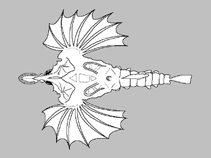http://www.fishbase.org/Summary/speciesSummary.php?genusname=Pegasus&speciesname=lancifer ---> http://192.134.151.83/Summary/speciesSummary.php?genusname=Pegasus&speciesname=lancifer
http://192.134.151.83/Summary/speciesSummary.php?genusname=Pegasus&speciesname=lancifer ---> https://fishbase.mnhn.fr/Summary/speciesSummary.php?genusname=Pegasus&speciesname=lancifer
https://fishbase.mnhn.fr/Summary/speciesSummary.php?genusname=Pegasus&speciesname=lancifer ---> https://fishbase.mnhn.fr/summary/Pegasus-lancifer.html
Pegasus lancifer, Sculptured seamoth

You can
sponsor
this page
Common name (e.g. trout)
Genus + Species (e.g. Gadus morhua)
-

-
About this page
-
Languages
-
User feedbacks
-
Citation
-
Uploads
-
Related species
-


 Sculptured seamoth
Add your observation in
Fish Watcher
Upload your
photos
and
videos
Sculptured seamoth
Add your observation in
Fish Watcher
Upload your
photos
and
videos
Google image
 No image available for this species;
No image available for this species;
drawing shows typical species in Pegasidae.
Teleostei (teleosts) >
Dactylopteriformes
(Flying gurnards) >
Pegasidae
(Seamoths)
Etymology:
Pegasus:
Taken form the winged horse of Perseus in the ancient Greek, mithology (Ref.
45335
)
;
lancifer:
From the Latin word 'lancea' meaning a light spear or lance.
.
More on author:
Kaup
.
Environment: milieu / climate zone / depth range / distribution range
Ecology
Marine; brackish; demersal; depth range 20 - 50 m (Ref.
75154
). Temperate; 33°S - 45°S
Eastern Indian Ocean: endemic to the temperate waters of southern Australia and Tasmania.
Size / Weight / Age
Maturity: L
m
?
range ? - ? cm
Max length : 9.1 cm SL male/unsexed; (Ref.
1418
)
Short description
Morphology
|
Morphometrics
Dorsal
spines
(total): 0;
Dorsal
soft rays
(total): 5;
Anal
spines
: 0;
Anal
soft rays
: 5;
Vertebrae
: 22. Body light to dark brown, olive or blue dorsally and laterally, light brown ventrally. Tail rings 14, anteriormost 7 mobile, remaining 7 fused; terminal tail rings with dorsal and ventral pairs of posteriorly directed spines; rostrum square in cross section; interpectoral plate absent. 4 pairs dorsolateral body plates; 5 pairs ventrolateral body plates; suborbital shelf convex, obscuring eye from ventral view; deep pits on dorsal surface of head and within interorbital depression absent. Orbit with small scales.
A benthic species found inshore of the continental shelf in muddy, silty and sandy bottoms, usually with seagrass; intertidal to 50 m depth (Ref.
75154
). Large numbers of individuals are known to congregate in the shallows of estuaries. The species is capable of burying itself in the sediment and change colors to match the background.
Life cycle and mating behavior
Maturity
|
Reproduction
|
Spawning
|
Eggs
|
Fecundity
|
Larvae
Spawning occurs as male & female swim from vent to vent, about 1 meter off the bottom, while they release eggs & sperms. The pair separates and each swims away as the eggs begin a pelagic phase.
Palsson, W.A. and T.W. Pietsch
, 1989. Revision of the Acanthopterygian fish Family Pegasidae (Order Gasterosteiformes). Indo-Pac. Fish. (18):38 p. (Ref.
1418
)
IUCN Red List Status (Ref.
130435
)
Least Concern (LC)
; Date assessed:
10 May 2016
CITES
Not Evaluated
Not Evaluated
Threat to humans
Harmless
Human uses
FAO - Publication:
search
|
FishSource
|
More information
Countries
FAO areas
Ecosystems
Occurrences
Introductions
Stocks
Ecology
Diet
Food items
Food consumption
Ration
Common names
Synonyms
Metabolism
Predators
Ecotoxicology
Reproduction
Maturity
Spawning
Spawning aggregation
Fecundity
Eggs
Egg development
Age/Size
Growth
Length-weight
Length-length
Length-frequencies
Morphometrics
Morphology
Larvae
Larval dynamics
Recruitment
Abundance
BRUVS
References
Aquaculture
Aquaculture profile
Strains
Genetics
Electrophoreses
Heritability
Diseases
Processing
Nutrients
Mass conversion
Collaborators
Pictures
Stamps, Coins Misc.
Sounds
Ciguatera
Speed
Swim. type
Gill area
Otoliths
Brains
Vision
Tools
E-book
|
Field guide
|
Length-frequency wizard
|
Life-history tool
|
Point map
|
Classification Tree
|
Catch-MSY
|
Special reports
Check for Aquarium maintenance
|
Check for Species Fact Sheets
|
Check for Aquaculture Fact Sheets
Download XML
Summary page
|
Point data
|
Common names
|
Photos
Internet sources
AFORO (otoliths) |
Aquatic Commons
|
BHL
|
Cloffa
|
BOLDSystems
|
Websites from users
|
Check FishWatcher
|
CISTI
|
Catalog of Fishes
:
genus
,
species
|
DiscoverLife
|
ECOTOX
| FAO - Publication:
search
|
Faunafri
| Fishipedia |
Fishtrace
| GenBank:
genome
,
nucleotide
| GloBI |
Google Books
|
Google Scholar
|
Google
| IGFA World Record |
MitoFish
|
Otolith Atlas of Taiwan Fishes
|
PubMed
| Reef Life Survey | Socotra Atlas |
Tree of Life
| Wikipedia:
Go
,
Search
| World Records Freshwater Fishing |
Zoobank
|
Zoological Record
Estimates based on models
Preferred temperature (Ref.
123201
): 14.6 - 18, mean 16 °C (based on 31 cells).
Phylogenetic diversity index (Ref.
82804
): PD
50
= 0.5781 [Uniqueness, from 0.5 = low to 2.0 = high].
Bayesian length-weight: a=0.01000 (0.00244 - 0.04107), b=3.04 (2.81 - 3.27), in cm total length, based on all LWR estimates for this body shape (Ref.
93245
).
Trophic level (Ref.
69278
): 3.3 ±0.4 se; based on size and trophs of closest relatives
Fishing Vulnerability (Ref.
59153
): Low vulnerability (10 of 100).
Back to Search
Random Species
Back to Top
Accessed through:
Not available
FishBase mirror site :
localhost
Page last modified by :
mrius-barile
- 20 July 2016
Fatal error
: Uncaught ArgumentCountError: Too few arguments to function checkEcotox(), 1 passed in /var/www/html/summary/speciessummary.php on line 2304 and exactly 3 expected in /var/www/html/includes/speciessummary.lib.php:2579 Stack trace: #0 /var/www/html/summary/speciessummary.php(2304): checkEcotox() #1 {main} thrown in
/var/www/html/includes/speciessummary.lib.php
on line
2579
|